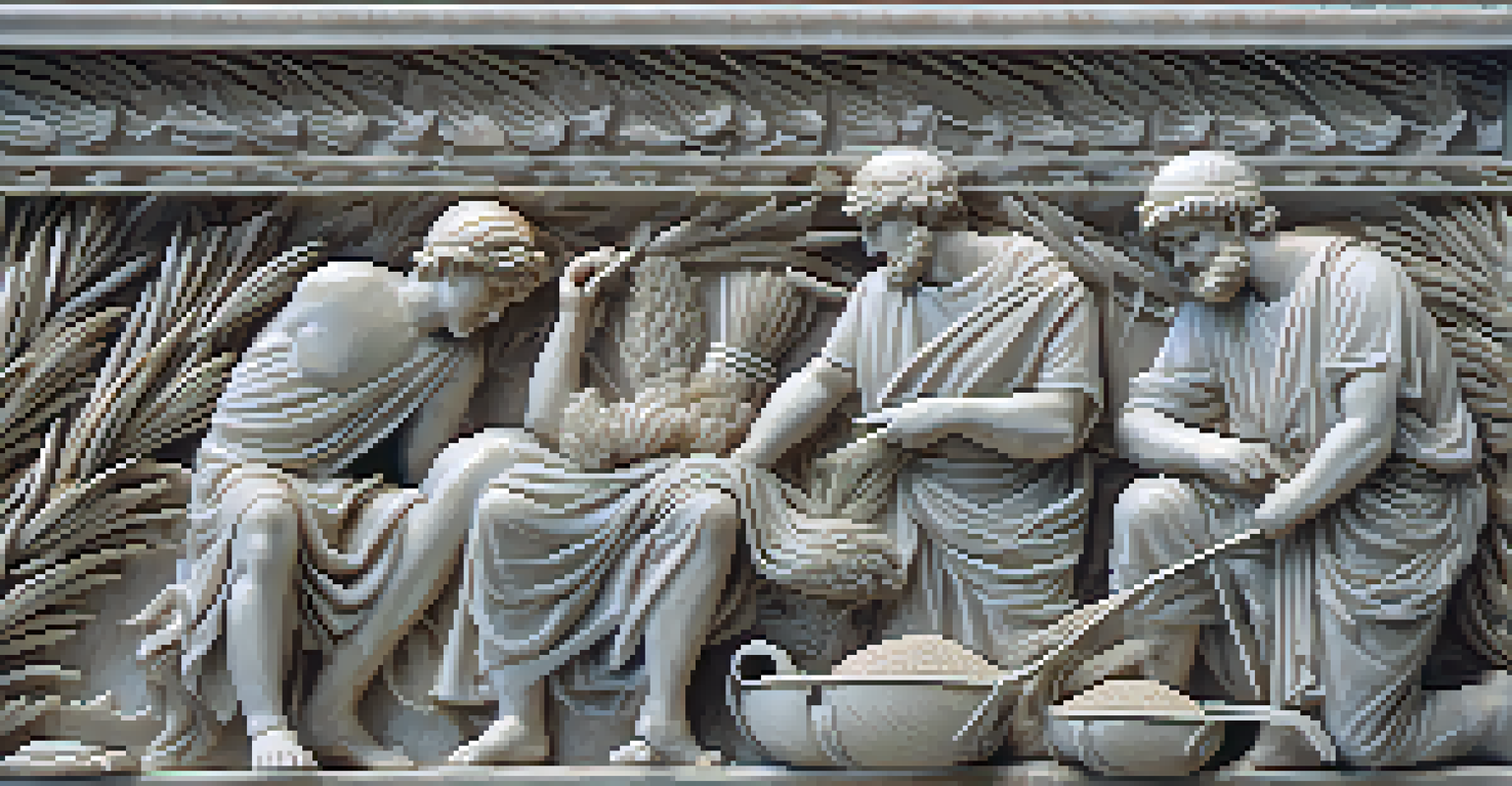Symbolism in Greek Carvings: A Window into Ancient Society

Understanding Greek Carvings and Their Significance
Greek carvings, often found on temples and public buildings, serve as a visual narrative of ancient society. These intricate artworks were not just decorative; they conveyed deep meanings and cultural values. By examining these carvings, we gain insights into the beliefs, myths, and societal structures that defined the Greek world.
Art is the most beautiful of all lies.
Each carving holds a story, often depicting gods, heroes, and everyday life. For instance, the depiction of Athena represents wisdom, while scenes of athletic competitions reflect the importance of physical prowess in Greek culture. These symbols were vital for communicating shared values and beliefs within the community.
Moreover, Greek carvings were designed to evoke emotional responses from viewers. Whether inspiring awe or reverence, they were integral in shaping the collective identity of the people. Understanding these artworks allows us to appreciate how they functioned as a bridge between the divine and the ordinary.
The Role of Mythology in Greek Carvings
Mythology played a crucial role in Greek society, and this is vividly reflected in their carvings. Many sculptures depict legendary tales involving gods and goddesses, serving as both entertainment and moral lessons for the public. By showcasing these stories, artists reinforced cultural values and societal norms.

For example, the myth of Hercules, often illustrated in various forms, symbolizes strength and perseverance. His depictions serve as a reminder of the virtues the Greeks admired and aspired to embody. This blend of art and narrative helped to keep these important stories alive for generations.
Cultural Values in Greek Carvings
Greek carvings serve as visual narratives that reflect the beliefs, myths, and societal structures of ancient Greece.
In many ways, these carvings acted as a form of storytelling, allowing people to connect with their heritage. They not only beautified spaces but also educated viewers about their myths and the lessons they imparted, ensuring that the wisdom of the ancients was passed down.
Symbolism of Daily Life in Greek Carvings
Beyond mythology, Greek carvings often reflect the daily lives of the people. Scenes depicting agricultural practices, trade, and family life provide a glimpse into the social fabric of ancient Greece. These artworks highlight the values surrounding hard work, community, and familial bonds.
The essence of art is to be a bridge between the divine and the ordinary.
For instance, carvings showcasing harvest festivals reveal the significance of agriculture in sustaining society. Such representations emphasize the connection between nature and community, illustrating how the Greeks revered the earth as a source of life. These symbols allowed individuals to celebrate their shared experiences.
Additionally, everyday life scenes help us understand the roles of men and women in society. By depicting various occupations and familial interactions, these carvings offer a window into gender roles and societal expectations, showcasing the norms that governed daily interactions.
Religious Symbolism in Greek Carvings
Religion was a cornerstone of ancient Greek life, and this is evident in their carvings. Many sculptures depict religious rituals and ceremonies, highlighting the importance of devotion and worship. Through these artworks, the Greeks communicated their reverence for the gods and the influence of divine power over their lives.
For example, the depiction of altars and offerings in carvings illustrates the significance of sacrifice in religious practices. These scenes remind us of the ways in which the Greeks sought favor from their deities, ensuring prosperity and protection in their lives. Each carving serves as a testament to the rituals that shaped their spiritual landscape.
Role of Mythology in Art
Mythological themes in Greek carvings reinforce cultural values and educate viewers about virtues admired in society.
Moreover, the presence of certain symbols, like laurel wreaths and animal sacrifices, further emphasizes the intertwining of religion and daily life. By understanding these elements, we can appreciate how deeply ingrained spirituality was in the fabric of Greek society.
Artistic Techniques and Their Symbolic Meanings
The artistic techniques used in Greek carvings also carry symbolic weight. Sculptors employed various methods, such as relief carving and contrapposto, to convey movement and emotion. These techniques enhanced the storytelling aspect of the carvings, making them more lifelike and relatable.
For instance, the use of contrapposto, where figures are depicted in a relaxed pose, symbolizes harmony and balance. This technique not only showcases the skill of the artist but also reflects the Greek ideal of beauty and proportion. Such choices in artistry were intentional, aiming to evoke specific feelings in the viewer.
Additionally, the materials chosen for carvings, such as marble and limestone, symbolize durability and permanence. The Greeks valued these materials for their strength and beauty, reflecting their desire for their creations to last through time. This emphasis on quality further illustrates the cultural importance placed on art as a legacy.
Political Symbolism in Greek Carvings
Greek carvings often served as political statements, reflecting the power dynamics of their society. Many sculptures were commissioned to commemorate victories or honor rulers, making art a tool for propaganda. Through these carvings, the Greeks celebrated their achievements and reinforced their political ideologies.
For example, the depiction of victorious athletes in public spaces symbolizes the values of competition and excellence that were central to Greek identity. These artworks not only celebrated individual accomplishments but also served to unify the community under shared ideals. They became a source of pride and inspiration for the populace.
Political Statements Through Art
Many Greek carvings acted as political propaganda, celebrating achievements and legitimizing the power of rulers.
Additionally, the portrayal of historical events in carvings often aimed to legitimize the power of leaders. By showcasing their lineage or divine favor, these artworks contributed to a narrative that justified their rule. This interplay between art and politics highlights the multifaceted role of carving in ancient Greek society.
The Legacy of Greek Carvings in Modern Society
The influence of Greek carvings extends far beyond their time, leaving a lasting legacy in modern society. Today, we see echoes of these ancient artworks in contemporary design and architecture. The classical elements borrowed from Greek carvings continue to inspire artists and architects around the world.
For instance, the use of columns and friezes in modern buildings reflects the enduring aesthetic appeal of Greek design. These elements serve as a reminder of the sophistication and beauty of ancient craftsmanship, allowing us to connect with the past. This influence is not just limited to architecture but also impacts various art forms.

Furthermore, the themes explored in Greek carvings, such as heroism, morality, and beauty, remain relevant in today's storytelling. By studying these ancient symbols, we gain insights into the human experience that transcend time, allowing us to draw parallels between ancient and modern values.